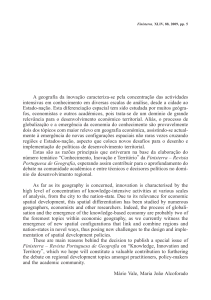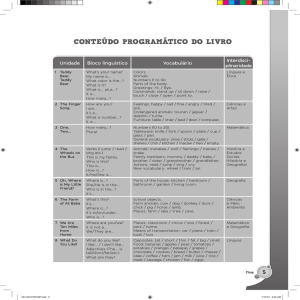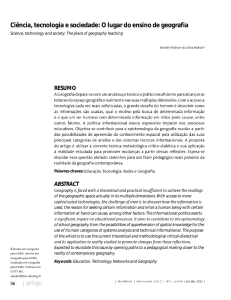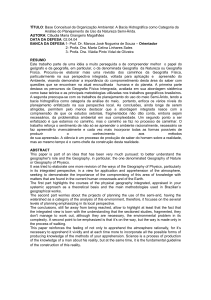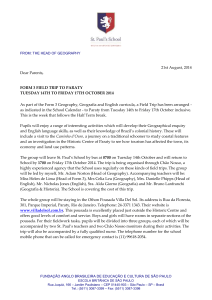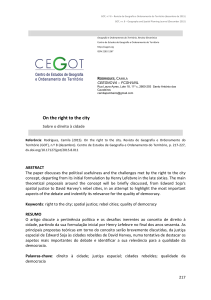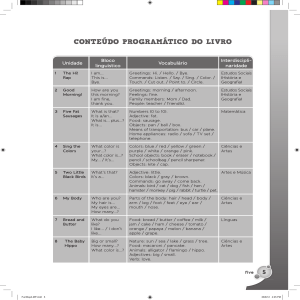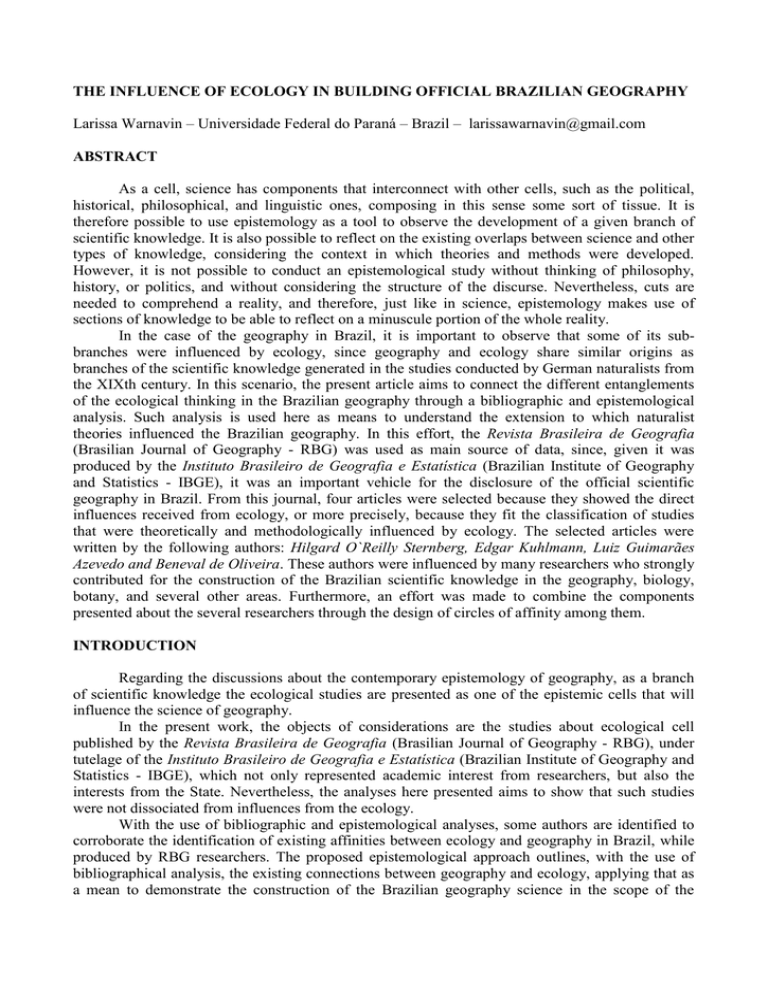
THE INFLUENCE OF ECOLOGY IN BUILDING OFFICIAL BRAZILIAN GEOGRAPHY
Larissa Warnavin – Universidade Federal do Paraná – Brazil – [email protected]
ABSTRACT
As a cell, science has components that interconnect with other cells, such as the political,
historical, philosophical, and linguistic ones, composing in this sense some sort of tissue. It is
therefore possible to use epistemology as a tool to observe the development of a given branch of
scientific knowledge. It is also possible to reflect on the existing overlaps between science and other
types of knowledge, considering the context in which theories and methods were developed.
However, it is not possible to conduct an epistemological study without thinking of philosophy,
history, or politics, and without considering the structure of the discurse. Nevertheless, cuts are
needed to comprehend a reality, and therefore, just like in science, epistemology makes use of
sections of knowledge to be able to reflect on a minuscule portion of the whole reality.
In the case of the geography in Brazil, it is important to observe that some of its subbranches were influenced by ecology, since geography and ecology share similar origins as
branches of the scientific knowledge generated in the studies conducted by German naturalists from
the XIXth century. In this scenario, the present article aims to connect the different entanglements
of the ecological thinking in the Brazilian geography through a bibliographic and epistemological
analysis. Such analysis is used here as means to understand the extension to which naturalist
theories influenced the Brazilian geography. In this effort, the Revista Brasileira de Geografia
(Brasilian Journal of Geography - RBG) was used as main source of data, since, given it was
produced by the Instituto Brasileiro de Geografia e Estatística (Brazilian Institute of Geography
and Statistics - IBGE), it was an important vehicle for the disclosure of the official scientific
geography in Brazil. From this journal, four articles were selected because they showed the direct
influences received from ecology, or more precisely, because they fit the classification of studies
that were theoretically and methodologically influenced by ecology. The selected articles were
written by the following authors: Hilgard O`Reilly Sternberg, Edgar Kuhlmann, Luiz Guimarães
Azevedo and Beneval de Oliveira. These authors were influenced by many researchers who strongly
contributed for the construction of the Brazilian scientific knowledge in the geography, biology,
botany, and several other areas. Furthermore, an effort was made to combine the components
presented about the several researchers through the design of circles of affinity among them.
INTRODUCTION
Regarding the discussions about the contemporary epistemology of geography, as a branch
of scientific knowledge the ecological studies are presented as one of the epistemic cells that will
influence the science of geography.
In the present work, the objects of considerations are the studies about ecological cell
published by the Revista Brasileira de Geografia (Brasilian Journal of Geography - RBG), under
tutelage of the Instituto Brasileiro de Geografia e Estatística (Brazilian Institute of Geography and
Statistics - IBGE), which not only represented academic interest from researchers, but also the
interests from the State. Nevertheless, the analyses here presented aims to show that such studies
were not dissociated from influences from the ecology.
With the use of bibliographic and epistemological analyses, some authors are identified to
corroborate the identification of existing affinities between ecology and geography in Brazil, while
produced by RBG researchers. The proposed epistemological approach outlines, with the use of
bibliographical analysis, the existing connections between geography and ecology, applying that as
a mean to demonstrate the construction of the Brazilian geography science in the scope of the
Official geography (geography of the State). It also identifies the main theories and methodologies
associated to ecology that guided Brazilian geography at that time.
By inserting this article into a wider context about the construction of knowledge, one can
be remembered that such construction is accomplished in the widest range of life sectors and in
different societies and cultures, for knowledge is universal and at the same time, individual. It does
not become truer according to its denomination (as in the case of the western scientific knowledge).
However, it is used as preposition in the present article, so that observations can be made on how
the scientific and geographic knowledge in Brazil is produced according to a game of influences
from a given thematic section.
To achieve such objective, first, a reflection on questions about research methodology is
introduced, as well as a brief theoretical discussion on the epistemology of geography; in a second
moment, the list of theoretical references used by authors is presented during a bibliographic
analysis, which discusses the possible epistemic consequences for the construction of a dialog
between geography and ecology. To finalize, possible circles of affinity among researchers are
outlined and new questions about the approach to the ecological and geographical thematic is
presented, having as base the science produced by IBGE in the cited period.
REFLECTION PARAMETERS
In the present article, society is faced as an organism, whereas science is considered one of
its cells. This cell, immersed in a self-adjustable and non-hierarchical organic whole, is subjected to
changes1. This reflection aims to draw a methodological outline capable of interpreting the existing
relationships between science and society, science and philosophy, science and history, and science
and discourse. It is evident that it is not possible to cover all the knots and entanglements of our
reality in only one publication. Therefore, just like in a model, such as the ones presented by
science, cuts will be needed so that a certain analysis2 can be conducted, even though these cuts can
be understood as synthesis3.
The initial cut, made to investigate influences from the ecological thinking in the Brazilian
geography, comes from the Revista Brasileira de Geografia (Brazilian Journal of Geography RBG) articles, published by the Instituto Brasileiro de Geografia e Estatística (Brazilian Institute of
Geography and Statistics - IBGE). This journal plays an important role on areas regarding scientific
publications, policies, and history of geography in Brazil. The discussed articles have in common
the utilization of ecological arguments to justify their analyses, or in other words, they used ecology
to propose solutions for spatial conflicts between society and nature.
The verification of these arguments was completed in three steps: 1- selection of articles
which showed the common use of an ecological cell discourse, and where the use of ecological
methods could be verified; 2- bibliographical and bibliometric analysis, to verify the sources used;
3- establishment of the relationships between ecological thinking cells4, basing on the idea of circles
of affinity (BERDOULAY. 1981).
It must be considered, however, that geography scholars, as well as scholars from several
cells of the scientific knowledge, have been dedicated over the last 40 years, to develop researches
related to environmental issues5, creating mechanisms of scientific analysis to comprehend the
problems related to the use and occupation of the geographical space. According to Mendonça
(1989), the methodological components that permeated the geography cell were varied and had
differences in the spatial approaches of the society-nature relationships. For studies of the physical
1
The ecological current in geography is closely related to naturalists from the XXth century, which justifies the option
to use the term cell, which comes from an organismic view of the world.
2
“Analysis and synthesis are the two terms of a dialectic opposition, both inseparable” (TRICART. 2006).
3
Idem.
4
Relates to the origin of a theory, of a method, and consequently, of a language used by a given domain of scientific
knowledge.
5
Understood as a critical period in the history of the industrial society, assuming that there is a conflict between society
and nature.
environment6, the systemic approach overruled the dialectics of nature. The following methods are
considered systemic: the study of the landscape7, the ecosystem8, the geosystem9, and the
ecogeography10 (MENDONÇA, 1989).
There is need to clarify that, in geography, the cell of environmental thinking differs from
the cell of ecological thinking, since they have different theoretical, methodological and therefore
discourse components, which can be observed throughout history. This way, it can be said that,
when it comes to the handling of the physical environment by geography, the diversity in methods
and theories of the sub-branches of this science (geomorphology, climatology, biogeography, soils
geography, hydro-geography) outline cells of their own thinking inside a referential structure.
It is also pointed out that, still, it is not very clear for some geography epistemologists that
such differences reflect in the way geographical knowledge is produced. That happens because the
epistemological approach that observes science through paradigmatic structures, plasters over other
types of analysis and observation, since, in an over-externalist manner, it proposes a synthesis
method to understand the development of sciences.
It is certain that there are groups of theories and methods which can define a paradigm, and
compose views of the world11. However, the paradigms point of view is not the only way to
investigate the structures of a science, as seen on the study proposed by Berdoulay (1981). In his
study, Berdoulay showed that the circles of affinity were constituted through the relationship among
geographers, who were connected either by direct contact, by personalities, or ideological views.
For the analysis here proposed, the cells of thinking are put as dynamic exchanges among
cells of the society. They cannot be understood as an end in themselves, as permanent groupings.
This dynamic system among knowledge and components of the reality are more subtly observed,
according to the following.
ESTABLISHING RELATIONSHIPS BETWEEN GEOGRAPHY AND ECOLOGY
The main guideline of the present research is to comprehend how the ecological cell
communicates with the geographical one, making it necessary to bring back the emergence of the
idea of ecology12. According to Drouin (1998), the term ecology was first used by the German
naturalist Ernest Haeckel (1834-1919), and was defined as “the science of economy, habits, and
mutual relationships among organisms”. In that sense, throughout the years between the end of the
XIXth century and the beginning of the XXth century, the term ecology was appropriated by
botanist-geographers to designate the study of the relationship between plants and their
environment.
“Landforms, rocks, soils, rivers, climates, vegetation, and fauna constitute elements of the physical environment”
(GUERRA. 1997).
7
“The notion of landscape comes from German geographers from the XIXth century, and its concept is overall of
physiognomic nature, being originally related to observation methods for scientific trips that were developed during that
century by Europeans (MENDONÇA, 1989).
8
“The ecosystem is a method to study nature that is specific to biology and ecology. Scientists related to these sciences
see such system in a vertical manner, meaning that they conceive nature through a storey structure of biogeochemical
cycles, biomass production, and phyto and zoosociological aspects (MENDONÇA, 1989).
9
“Geosystem is the expression of natural phenomena, or in other words, the ecological potential of a given space in
which biological exploitation takes place, and in which social and economical factors can influence the spatial structure
and expression without necessarily having an internal homogeneity in face of the dynamic processes” (MENDONÇA,
1989).
10
“Ecogeography, in a generic definition, is the study of how humans integrate themselves in ecosystems and how this
integration is diversified in function of the terrestrial space” (MENDONÇA, 1989).
11
Worldview or “Weltanschauung as the global outlook of an epoch assumes a central role in this task science
interpretation involves a location of cultural products within a totality of which they constitute meaningful parts.”
(LARRAIN,1979).
12
German naturalist Alexandre Von Humboldt in 1805 inserts the term phytogeography to define the study of plants’
distribution and their relationship with the environment (NUCCI. 2007).
6
The ample utilization of the term by scientists from Anglo-Saxon countries can be verified
on articles from several scientific journals (DROUIN. 1998). Also in Brazil, the analysis of RBG
articles showed that some of them did characterized ecology as a naturalist science that studies the
relationships between the vegetation and its space. The conducted bibliometric analysis, however,
points out that from the 60 articles selected as related to natural resources, ecological and
environmental themes, only four were found with direct arguments of an ecological cell.
Nevertheless, it is important to highlight that not all articles dealing with the spatial distribution of
vegetation can be considered as connected to ecology, even though they might mention this science.
In that sense, differently from what was proposed by Andrade (1987), in geography the ecological
current differs from the environmental current, for the first has its cell of thoughts based on the
XIXth century naturalism, while the second emerges after the Second World War and not
necessarily uses ecology as a method, it can be considered, thus, that both developed differently in
the sub-branches of geography.
Still regarding the development of geography in Brazil, it is important to stress that, from
1939 onwards, RBG started to be published by IBGE. According to Monteiro (1980. p.10), this
organ, which is connected to the National Council of Geography (CNG) and has been adhered to
the International Geographical Union (IGU), was founded in 1934 by the Brazilian government, in
the context of the Estado Novo13. IBGE can be considered the only institutional organ in Brazil
directly connected to the State’s central power. Furthermore, the science of geography in Brazil was
also established through the creation of the São Paulo and Rio de Janeiro Universities (1934 and
1940, respectively), and the Brazilian Association of Geographers – AGB, in 1934. In 1938 the
Geography course is also implemented at the Federal University of Paraná, and together, these
institutions had the main purpose of raising the Brazilian government’s knowledge about the
national territory.
In this context, the first RBG article analyzed dates from 1949 and was published by
geographer Hilgard O`Reilly Sternberg (1917-2011), who dedicated his career mainly to the study
of geomorphology. At that time, the author was connected to the National Faculty of Philosophy at
the Rio Branco Institute. The article “Enchentes e movimentos coletivos do solo no vale do Paraíba
em dezembro de 1948 – Influência da explotação destrutiva das terras” (“Floods and soil collective
movements in the Paraíba Valley in December of 1948 – Influence of the destructive exploitation of
lands”), was the result of an investigation on the existing relationships between soil conditions and
the vegetation cover, as well as the characteristics of the watershed (geological structure and
topography) and meteorological factors (rain amount and distribution) that triggered erosive
processes, affecting the Paraíba Valley community’s life.
Through the description of chosen components of the physical environment and the use of
maps, synoptic letters, photos, and an analysis of the historical occupation, the author considers that
the agricultural system implemented in the region is an important factor that imbalances the
biological cycle, pointing out that “deserts made by the contemporary man are everywhere”
(STERNBERG. 1949. p.81). Sternberg then reflects about preventive actions for the agricultural
system that would allow minimizing the impacts caused by erosion.
Another important criterion to classify this article as inserted in the cell of ecological
thinking, is the reference to the studies by the German bio-geographer Carl Troll14 (1988-1975)
about the “ill consequences of an inappropriate occupation of the soil” (STERNBERG. 1949. p.87).
Carl Troll was an important German geographer and botanist who dedicated his studies to the
diversification in the distribution of vegetation. In 1938 he introduced the term landschaftsekologie
or Landscape Ecology. One year later, in 1939, British botanist Arthur George Tansley (1871-1955)
introduced the term ecosystem, which has some similarities with the landscape ecology term
(TROPPMAIR. 2000).
13
Estado Novo was a centralized and authoritarian Brazilian political regime implemented by President Getúlio Vargas
between 1937 and 1945.
14
TROLL, Carl. “Koloniale Raumplanung in Afrika”. Offprint from Zeitschrift der Gesellschaft fur Erdkunde zu
Berlin,.1941. n. 4. p. 4-5.
The second article to be analyzed was written in 1954 by Edgar Kuhlmann (1920- ), a biogeographer connected at the time to the CNG. He published the article “A vegetação de Mato
Grosso – Seus reflexos na economia do Estado” (“The vegetation of Mato Grosso – Its reflexes in
the state’s economy”), in which he conducted a thorough study of the vegetation, listing the
population, economical and vegetation aspects. He used relief, soil and climate variables to identify
the vegetation, and he also presented maps, photos and sketches to demonstrate the type of
occupation in each of the different vegetation types presented. He pointed out the anthropological
actions as an aggravating item in the process of soil erosion, and described the abusive practice of
natural resources collection from the woods, and the practice of setting fire to the forest, as main
agents of destruction in the cerrado, the Brazilian savannah.
The theoretical references of this article point to a direct influence from ecology. There are
several cited authors who have their main focus on the spatial study of vegetation; however, among
these authors the work by the Danish botanist Eugenius Warming15 (1841-1924), who published the
first plant ecology treatise in history, can be highlighted. This researcher was in Brazil between
1863 and 1866, working in Lagoa Santa – Minas Gerais State, along with the Danish naturalist
Peter Lund (1801-1880) (KLEIN. 2002). Kuhlmann’s article is also influenced by the German
botanist Felix Kurt Rawitscher (1890-1957)16, who was responsible for organizing the Department
of Botany of the São Paulo University in 1934, while also dedicating part of his studies to tropical
ecology (MORRETES.1994). It is important to also highlight the influence in this article by Léo
Waibel (1988-1951)17, important German geographer who introduced the term Kulturlandschaft or
Cultural Landscape, through his studies of agrarian geography (ETGES. 2000). In the references
section of this article, a set of authors cited in the publication by Edgar Kuhlman, including Felix
Kurt Rawitscher18 and Léo Waibel19 can be found.
In 1967 (n.2), Luiz Guimarães Azevedo, a biologist at the Botanical Institute of the Secretary
of Agriculture of the São Paulo State, publishes “Tipos Eco-Fisionômicos de Vegetação do
Território Federal do Amapá” (“Plant eco-physiognomic types in the federal territory of Amapá”),
which is the third article to be analyzed in this study. Azevedo used techniques of photointerpretation to map the types of vegetation, while adopting the concept of physical environment.
He focused on making an eco-physiognomic survey that could serve the biological and several other
sciences. He pointed the thorough study of phitosociology and plant ecology as tools that can
present the exact limits of the vegetation. He also suggested the allegiance of this knowledge to the
global and synthetic vision of the phenomena described in the bio-geographical scenario, which
would provide immediate knowledge of the current natural resources in a time-saving and efficient
manner that is needed for this kind of study.
Among the vast collection of works cited in this article, some authors related to the cell of
ecological thinking must be highlighted. One of them is the Swiss botanist Jacques Huber (18671914)20, who worked at the Museu Paraense Emílio Goeldi, in Belém, between 1895 and 1914
(CUNHA. 2009), together with the Brazilian botanist Adolpho Ducke21 (1876-1959)
(CAVALCANTE. 1981). Another important author who was cited is the agriculturist Alceo
Magnanini22 (1925), who joined IBGE as a member of the institution’s permanent board of
15
WARMING, Eugenius. Lagoa Santa, 1982. Belo Horizonte, 1908.
RAWITSCHER, Felix. Problemas das savanas brasileiras e das savanas em geral.
17
WAIBEL, Leo. Vegetação e uso da terra no Planalto Central. Revista Brasileira de Geografia. v.10. n.3. Rio de
Janeiro. 1948.
18
RAWITSCHER, Felix. Problemas de fitoecologia em considerações especiais sobre o Brasil Meridional. Boletim da
Faculdade de Filosofia Ciências e Artes da Universidade de São Paulo.
19
WAIBEL, Leo. Vegetation and Land use in the Planalto de Goiás. Geographical Review. v.38. 1948.
20
HUBER, J. Contribuição à Geografia Botânica do litoral da Guiana entre o Amazonas e o Oiapoque. Boletim do
Museu Goeldi.
21
DUCKE, A. Amazônia Brasileira. Instituto Nacional do Pinho. Rio de Janeiro, 1948. DUCKE, A. BLACK G. A.
Notas sobre a fitogeografia da Amazônia Brasileira. Instituto Agronômico do Norte. Belém, 1954.
22
MAGNANINI, A. As regiões naturais do Amapá. Revista Brasileira de Geografia. v.14. n.3. map.8. fot.20. graf.17.
bloc. diagr.1. Conselho Nacional de Geografia. Rio de Janeiro, 1952
16
geographers, and who is one of the specialists responsible for the organization of the Brazilian
Forest Code from 1965. Furthermore, Magnanini was part of a group responsible for “developing
studies about biogeography at IBGE, beside Walter Alberto Egler, Dora do Amarante Romariz,
Edgar Kuhlman and Paul Claude Courbet” (IBGE. 2011). Azevedo mentions the work of André
Aubréville (1897-1982), a water and forests engineer specialized in botany who published in 1961
the “Estudo ecológico das principais formações vegetais do Brasil e contribuição ao conhecimento
das florestas da Amazônia brasileira” (Ecological study of the main plant formations in Brazil and
contributions to the knowledge of forests in the Brazilian Amazon) and is considered to be
responsible for the popularization of the term desertification.
Finally, the last article to be analyzed was written by Beneval de Oliveira in 1970 (n.1),
under the title of “A destruição do cerrado e o reflorestamento como meio de valorização regional”
(The destruction of the cerrado and reforestation as a mean of local valuation). In this article he
highlights the amount of studies related to the cerrado theme, as well as the exploitation of natural
resources from underdeveloped areas, which would be quickly being destroyed. He sustains that the
cerrado would have been generated by anthropogenic actions and alerts to the danger in altering the
natural conditions of the soil. In order to do that, he uses as strategy the evidence of the conflicting
relationship between man and the environment, pointing out grazing activities as harmful to the
cerrado.
It is important to stress that the author mentioned a project presented at the Meeting of
Forest Researchers, promoted by the Instituto Brasileiro de Desenvolvimento Florestal (Brazilian
Institute for Forestry Development - IBDF) in 1969, in Belo Horizonte, where the “Management of
the Cerrado under a Sustained Production System” was debated. To the author, “the conservation of
the soil will, likewise, be one of the indispensable elements for the establishment and relocation of
the cerrado flora, especially in face of the poor humate23 and changing elements” (OLIVEIRA,
1970, p.60).
According to Oliveira (1970), who was worried about problems of such magnitude, IBDF
could aim for the valuation of cerrado areas, while established in Brasília, become a central facility
for forest researches and the training of specialized staff that would operate in the cerrado and
create a commissions of technical standards, through which conditions would be given so that the
regional reforestation would become a reality. Such ample researches should comprise not only
themes related to the forest industry application, but also the so called basic researches, which are of
direct interest to ecology. These researches would reflect on the improvement of microclimatic
conditions and their relationship to the soil, water, fauna, flora and other regimes” (OLIVEIRA,
1970. p.60).
Oliveira (1970. p.63) infers, however, that the land occupation, colonization and forest
exploitation in modern times are activities that cannot be dissociated, so intimate are the factors that
interfere in natural locations. “The problems related to forests, for example, are undoubtedly
important for the landscape, especially given that they are connected to the conservation of the soil
and to the balance and protection of the natural environment, a fact that the modern man cannot
ignore” (p.63).
Oliveira uses terms from ecology such as climax or subclimax vegetation, where ecological
influences from the botanist Carlos Toledo Rizzini (1921-1992) 24 and from ecologists Mário
Guimarães Ferri (1918-1985) and Leopoldo Magno Coutinho25 are noted. Furthermore, Oliveira
also cites the important work by ecologists John Ernest Weaver (1884-1966) and Frederic Edward
Clements (1874-1945)26 about plant ecology.
23
Acid salts resulted from decomposed prehistoric plants and animals.
RIZZINI, C.T. A Flora do Cerrado (Análise florística das savanas centrais). Separata do volume Simpósio sobre o
Cerrado. Editora da Universidade de São Paulo. 1963. RIZZINI, C.T. HERINGER, E. P. Preliminares acerca das
formações vegetais e do reflorestamento no Brasil Central. Edições S. A. Rio. MA. 1962. RIZZINI, C.T. Problemas de
aproveitamento da vegetação no Cerrado. Trabalho apresentado ao CETEPEC. Brasília, 1963.
25
FERRI, M. G. COUTINHO, L. M. Contribuição ao conhecimento da Ecologia do Cerrado. Boletim da Faculdade de
Filosofia, Ciências e Letras. n. 15. Universidade de São Paulo. 1958.
26
WEAVER, John. CLEMENTS, F. Ecologia Vegetal. Acme. Agency. Buenos Aires, 1950.
24
FINAL REFLECTIONS: DESIGNING CIRCLES
The articles here discussed showed to be directly influenced by ecological thinking from
several sources. Even though they used variables from geomorphology, pedology, climatology, and
in some cases, economy, their preference for investigations about the development of the vegetation
cover is evident, coming close to biogeography studies. The only exception is Stemberg’s article
(1949), where he writes about erosive processes, which are related to the geography of soils and to
geomorphology. In his article, the influence by biogeographer Troll is evidenced when he tries to
justify his study through an integrated view of the landscape elements, and highlights the
importance of soils and of the vegetation cover for the analysis of erosive processes. Regarding the
sub-branches of biogeography, the texts by Kuhlman (1954) and Oliveira (1970) indicate the
existence of two main circles of affinity. The first with botanist Rawitscher influencing on plant
ecology issues, and the second with geographer Waibel addressing aspects of the vegetation in the
Planalto Central. This shows that, the location factor of the research objects can influence the
formation of circles of affinity. Azevedo’s study (1967), on its turn, even though contributed mainly
to plant cartography methods, can be considered as equally belonging to biogeography, and related
to mainly two circles of affinity: one from botanists Huber and Ducke, from the Museu Paraense
Emílio Goeldi; and another from IBGE researchers Magnanini, Egler, Romariz, Kuhlman and
Coubert.
Still using the bibliographic references as means to map the influences that permeated the
Brazilian geography, it is possible to Adress the pré-existing discussion on the discussion on
colonial science versus national science, as proposed by Polanco (1989). In such type of discussion,
the bibliometric analysis could offer subsidies for the verification of the degree of development in a
scientific community, based on the analysis of the languages used in citations. In the case of the
articles here analyzed, the number of Brazilian citations is greater than the foreign ones. If a time
variable is considered in the present sampling, the number of citations from foreign sources is
significantly reduced. An example is found on Kuhlman’s text (1954), where only sources in the
Portuguese language are used, characterizing, in part, the construction of a local scientific tradition.
Considering the accessibility to sources and the State’s preference for researches on some
given areas of the Brazilian territory, the use of research sources from several Brazilian institutes
shows the official character of RBG’s geography, as an adjunct to occupation and knowledge of the
Brazilian territory.
Other RBG articles, besides the ones selected in this study, were found to be consonant with
the cell of ecological thinking, if biogeography articles were to be considered. However, there is a
conflict since the 1970’s in the utilization of the terms ecology, nature, ecosystem, natural resources
and environment, even though the use of scientific terms is considered an important reference in the
distinction among circles of affinity. In that sense, it was necessary to work with a sampling to
delimitate the focused theme, which was about the cell of the ecological thinking, and which uses
theories, methods, and terminologies from ecology.
To set the limits on the circles of affinity with wider definitions, it is necessary to go beyond
a bibliographic investigation. A historical investigation is needed to allow the identification of the
processes which led to the contacts between researchers, especially when they came from pioneer
scientists. Therefore, although there are several ways to map the existing circles of affinity among
researchers, it is also necessary to insert them in a wider historical context. Quoting Monteiro
(2008. P.321): “what we want to be emerged here – is certainly much smaller than the tip of a huge
iceberg – are “focuses” which, while circling around dualisms or opponent matters can, under
different observation angles, configure the knots or entanglements of the issue”. In this sense, this
study looked for a middle term between the internalist and the externalist visions of the
epistemological practice, opening up for the possibility of deepening this investigation in endless
directions.
REFERENCES
AZEVEDO, Luiz Guimarães de. Tipos Eco-Fisionômicos de Vegetação do Território Federal do
Amapá. Revista Brasileira de Geografia, Instituto Brasileiro de Geografia e Estatística, Rio de
Janeiro, n. 2, p. 25-51, 1967.
BERDOULAY, Vicent. La formation de L’École Française de Géographie (1870-1914). Mémoires
de La Section de Géographie. n.11. Bibliothéque Nationale. Paris, 1981.
CAVALCANTE, Paulo B. O INPA e o Museu Goeldi nos 30 anos do CNPq: A Divisão de
Botânica do Museu Goeldi. Acta Amazonica. (suplemento), V.11. N.1. Editora do INPA. Manaus,
1981. Available at: <http://acta.inpa.gov.br/fasciculos/11-1/PDF/v11n1a40.pdf>
CUNHA, Osvaldo Rodrigues da. Jacques Huber (1867-1914). Boletim do Museu Paraense Emílio
Goeldi.
Ciências
Humanas.
v.4.
n.3.
Belém,
2009.
Available
at:
<http://www.scielo.br/scielo.php?pid=S1981-81222009000300010&script=sci_arttext.>
DROUIN, Jean-Marc. L’écologie: généalogie d’une discipline. In: AUBERT, Francis.
SYLVESTRE, Jean-Piere. Écologie et Societé. Educagri editions. Dijon, 1998.
ETGES, Virgínia Elisabeta. A paisagem agrária na obra de Léo Waibel. GEOgraphia. v.2. n.4.
Universidade Federal Fluminense. Niterói, 2000.
GUERRA, Antônio Teixeira. GUERRA, Antônio José Teixeira. Novo Dicionário GeológicoGeomorológico. Rio de Janeiro: Bertrand Brasil, 1997.
IBGE. Alceo Magnanini. História Oral. Rio de Janeiro,
<http://www.ibge.gov.br/historiaoral/perfil.php?id_servidor=90>
2011.
Available
at:
LARRAIN, Jorge. The concept of Ideology. Hutchinson University library. London, 1979.
Available at: <http://books.google.com.br/books?id=9ocOAAAAQAAJ&source= gbs_navlinks _s>
KLEIN, Aldo Luiz. (org.). Eugen Warming e o Cerrado Brasileiro: um século depois. Editora
UNESP. São Paulo, 2002.
KUHLMANN, Edgar. A vegetação de Mato Grosso – Seus reflexos na economia do Estado.
Revista Brasileira de Geografia. Instituto Brasileiro de Geografia e Estatística, Rio de Janeiro, n. 4,
p. 77-122, 1954.
MENDONÇA, Francisco. Geografia física: ciência humana? São Paulo: Contexto, 1989.
MONTEIRO, Carlos A. F. A Geografia no Brasil (1934 – 1977): Avaliação de Tendências. Série
Teses e Monografias. São Paulo: IGEO-USP, n. 37, 155 p, 1980.
MONTEIRO, C. A. F. Tempo de Balaio. Série Livros Geográfico I. GCN. CFH. UFSC. UFPI.
Florianópolis, 2008.
MORRETES, Berta Lange de. Felix Rawitscher. Estudos Avançados. v.8. n.22.1994. p. 205-208.
Available at: <http://www.scielo.br/pdf/ea/v8n22/21.pdf>
NUCCI, João Carlos. Origem e desenvolvimento da ecologia e da ecologia da paisagem. Revista
eletrônica
Geografar.
v.2.
n.1.
Cutitiba,
2007.
p.
77-99.
Available
at:
<http://dc220.4shared.com/doc/j20JWMQO/preview.html>
OLIVEIRA, Beneval de. A destruição do cerrado e o reflorestamento como meio de valorização
regional. Revista Brasileira de Geografia. Instituto Brasileiro de Geografia e Estatística, Rio de
Janeiro, n. 1, p. 43-66, 1970.
POLANCO, Xavier. “Une science-monde: la mondialisation de la science européne et la création de
traditions scientifiques locales.” In: POLANCO, Xavier (dir.) Naissance et Développement de la
Science-Monde. Paris, Ed. La Découverte/Unesco, 1989. (pp. 10-53
STERNBERG, Hilgard O’Reilly. Enchentes e movimentos coletivos do solo no Vale do Paraíba em
dezembro de 1948 – Influência da explotação destrutiva das terras. Revista Brasileira de Geografia.
Instituto Brasileiro de Geografia e Estatística, n. 2, p. 67-105, 1949.
TRICART, Jean. O campo na Dialética da Geografia. Revista do Departamento de Geografia. n.19.
Universidade de São Paulo. 2006. p.104-110.
TROPPMAIR. Ecologia da paisagem: uma retrospectiva. I Fórum de debates: Ecologia da
paisagem e planejamento ambiental. Sociedade de Ecologia do Brasil. Rio Claro, 2000. Available
at: <http://www.seb-ecologia.org.br/forum/art24.htm>


